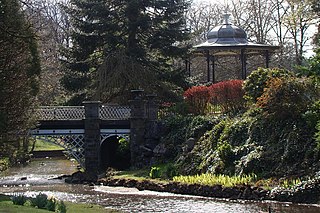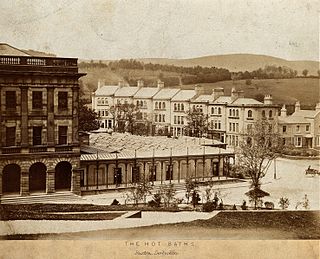
Buxton is a spa town in the Borough of High Peak, Derbyshire, in the East Midlands region of England. It is England's highest market town, sited at some 1,000 feet (300 m) above sea level. It lies close to Cheshire to the west and Staffordshire to the south, on the edge of the Peak District National Park. In 1974, the municipal borough merged with other nearby boroughs, including Glossop, to form the local government district and borough of High Peak.

Thermae Bath Spa is a combination of the historic spa and a contemporary building in the city of Bath, England, and reopened in 2006. Bath and North East Somerset council own the buildings, and, as decreed in a Royal Charter of 1590, are the guardians of the spring waters, which are the only naturally hot, mineral-rich waters in the UK. The Spa is operated by YTL Hotels.

The history of Derbyshire can be traced back to human settlement since the last Ice Age, over 10,000 years ago. The county of Derbyshire in England dates back to the 11th century.

Solomon's Temple, also known as Grinlow Tower, is a Victorian folly on the summit of Grin Low hill, near the spa town of Buxton in the Derbyshire Peak District.

Henry Currey (1820–1900) was an English architect and surveyor.

The Devonshire Dome building is a Grade II* listed 18th-century former stable block in Buxton, Derbyshire. It was built by John Carr of York and extended by architect Robert Rippon Duke, who added what was then the world's largest unsupported dome, with a diameter of 44.2 metres (145 ft). It is now the site of the Buxton Campus of the University of Derby.

The Old Hall Hotel is a hotel in Buxton, Derbyshire, England, and is one of the oldest buildings in the town. The current building dates from the Restoration period, built around and incorporating an earlier fortified tower.

The Devonshire Royal Hospital was established as the Devonshire Hospital in 1859 in Buxton, Derbyshire by the Buxton Bath Charity for the treatment of the poor. The hospital was built in the converted stable block of The Crescent. The building is now known as the Devonshire Dome and it is the site of the Buxton Campus of the University of Derby.

Buxton Pavilion Gardens is a Victorian landscaped public park in the spa town of Buxton in Derbyshire. The River Wye flows through the gardens, which are a Grade II* listed public park of Special Historic Interest.

St John The Baptist Church is a Grade II* listed parish church in the Church of England in Buxton, Derbyshire.

The Square is a Grade-II*-listed building in Buxton, Derbyshire, England. It lies in the town's central Conservation Area immediately between The Crescent, the Old Hall Hotel, the Pavilion Gardens and the Buxton Opera House.

The Slopes is a Grade-II-listed public park in Buxton, Derbyshire in England. The area was laid out by landscape architect Jeffry Wyatville in 1811 for William Cavendish, 6th Duke of Devonshire, as pleasure grounds for the guests of The Crescent hotel to promenade. The design of The Terrace was modified further by Sir Joseph Paxton in 1859.

Grin Low is a hill overlooking Buxton in Derbyshire, in the Peak District. The summit is 434 metres (1,424 ft) above sea level.

St Ann's Well is an ancient warm natural spring in Buxton, Derbyshire in England. The drinking well is located at the foot of The Slopes and opposite the Crescent hotel and the Old Hall Hotel.

The Palace Hotel was opened in 1868 in Buxton, Derbyshire, England. It holds a prominent position in the town's central Conservation Area overlooking the town. It is a Grade-II listed building.

The Buxton Baths using natural thermal spring water are in Buxton, Derbyshire, England. The baths date back to Roman times and were the basis for developing Buxton as a Georgian and Victorian spa town. The present buildings of the Thermal Baths and the Natural Mineral Baths were opened in the 1850s. They are positioned either side of the Buxton Crescent at the foot of The Slopes in the town's Central Conservation Area. They are both Grade II listed buildings designed by Henry Currey, architect for the 7th Duke of Devonshire.
William Radford Bryden was an English architect and surveyor who designed various prominent Victorian buildings in Buxton, Derbyshire.

Buxton is a spa town in the High Peak district of Derbyshire, England. The town contains 93 listed buildings that are recorded in the National Heritage List for England. Of these, one is listed at Grade I, the highest of the three grades, seven are at Grade II*, the middle grade, and the others are at Grade II, the lowest grade. That the town was a source of natural water springs has been known at least since Roman times, and during the medieval period, St Ann's Well was a shrine and a place of pilgrimage. Buxton developed into a spa town during the 18th and 19th centuries, largely under the influence of the Dukes of Devonshire. The water was considered to have curative powers, and this led to the building of bath houses and later a hospital. Later, leisure facilities grew, and were served by the Pavilion Gardens, and the building of a conservatory, a theatre, a concert hall, and an opera house.
























